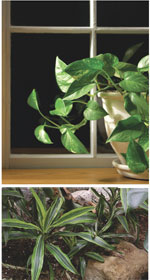
It's Alright in Low Light
By on Sep 06, 2007

by Veronica Sliva
Brightening up your home with plants not only
enhances your surroundings, but when usedimaginatively serves practical functions as well. With
a little inspiration you can create stunning displays, addtexture and colour to a room, modify straight lines, and
soften the harsh contours of furniture. An attractive planter,for example, can divide a room as effectively as a partition
made of wood or chrome. A small indoor garden can roundout an awkward living room corner. Strategically placed
plants can camouflage aesthetic or architectural problems(such as the spot where the cat clawed the wallpaper). In the
summer months, mass foliage transforms an empty fireplace, giving it an elegant and fresh look. Houseplants come in a wideassortment of sizes, shapes, textures, and colours and they bring
a dimension to your home that can only live plants can offer.
The parts of our homes that are most in need of a lift are
usually the places that at first seem less-than-ideal for livingplants. Typically, they are the spots that we think are too dark
for anything to grow in. But there's a plant for almost everylocation-the trick is to choose the right one for all those
so-called wrong places.
Floor plants
light. But not to worry, some plants actually thrive up to 10
feet away from the nearest window. Certain palms workespecially well; two that are very comfortable in indirect light
are the kentia (Howeia) and parlor (Chamaedorea) palms.Their feathery leaves blend in well with any furnishings.
Other shady characters belong to the Dracaena family
(sometimes called Dragon Tree). They are almost impossibleto kill and are content with artificial or very little natural light.
Dracaena varieties such as fragrans, commonly known asthe corn plant, were popular decades ago and are making a
comeback. Other Dracaena varieties to consider arewarneckii, Janet Craig, godseffiana, sanderiana, borinquensis,
and compacta.
Usually you have to forego flowers in low light, but peace
lilies (Spathiphyllum) are happy in dim situations. And, if
given a warm room with adequate humidity, they will rewardyou with lovely white blooms.

And then there's one of the easiest of all plants to grow, the
green-and-white-striped spider plant (Chlorophytumcomosum 'Variegatum') and its green cousin, Chlorophytum
capense. Every home should have a few spider plants becauseresearch has shown that they improve indoor air quality by
removing many of the harmful chemicals from the air. If theyare really happy, they'll sprout new babies from runners that
you can pot to increase your collection.
Windowless wonders
Yes, some plants fare well even in a windowless room or
hallway with only an artificial light source. Chinese evergreen(Aglaonema) is one of them. It's a handsome plant that has
dark green leaves with white splotches and is one of the mostdurable houseplants you'll ever find. It tolerates poor light, dry
air, air conditioning, drought, and a fair bit of neglect.
Heartleaf philodendrons are also good candidates to perk
up a dimly lit spot, and they don't need to be fussed over,
either. Philodendron elongatum is the best-known species.The large, shiny leaves, as the name suggests, are heart-shaped.
This is the vine that you most often see climbing up a pieceof bark.
Assess your light
lighting conditions you have to work with and then choose the
plants whose needs match your environment. That way youand your plants will be much happier with one another.


